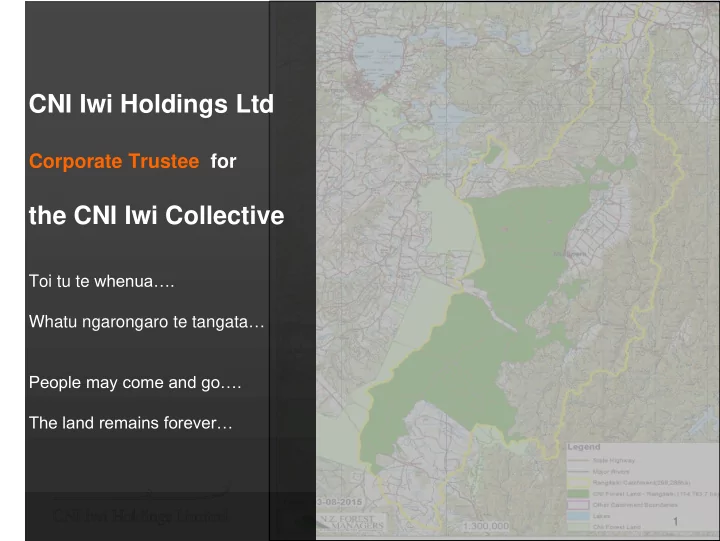

CNI Iwi Holdings Ltd Corporate Trustee for the CNI Iwi Collective Toi tu te whenua…. Whatu ngarongaro te tangata … People may come and go…. The land remains forever… 1 1
1. CNIIHL Context for interacting with Proposed Plan Change 10 2. Policy Development process 3. Policy Development Logic 2
Timeline 1900’s land confiscated / acquired by the Crown through illegal means 1980’s – 2005 Crown and Iwi tried various approaches to work towards settlement 2005 Iwi met to discuss a collective approach led by Te Ariki Tumu Te Heuheu 2008 CNI Iwi Collective Deed of Settlement signed 3 3
The Land June 2009 the 8 Iwi received 176,000 Ha of CNI Forest land ≈142,000 Ha in the Bay of Plenty ≈3,100 Ha in the Lake Rotorua Catchment Land returned under Crown Forestry Licenses i.e. in forest for up to 35 years 4 4
The People Ngāti Whare Ngāti Manawa Ngai Tūhoe Ngāti Tūwharetoa Ngāti Rangitihi Te Pumautanga o Te Arawa Raukawa Ngāti Whakaue Collectively > 110,000 people 5 5
CNI Iwi Holdings Ltd CNIIHL holds and manages the land until 2043 Governed by a Board of 16 Directors (2 directors per Iwi) Formal engagement with CNIIHL is through the Board. Land management by wholly owned subsidiary CNI Iwi Land Management Ltd 6 6
Aspirations Create a future for our people where opportunities abound and we have a thriving, happy, prosperous community 7 7
Aspirations To maximise wealth through operating a successful commercial business, respectful of tikanga and the environment To manage the land and opportunities for current and future generations. 8 8
Aspirations Achieving best practice in all our dealings and relationships Work with long term partners who can add value 9 9
Challenges Crown Forest Licenses for up to 35 years For wealth creation and stability we need to: 1. unlock the potential of the land 2. retain resources to be able to use it o Carbon o Water o Nutrients PC 10 Effect on CNI 3000Ha >$43m - on lost optionality or - cost of bought N. 10 10
Challenges • 1900’s land confiscated • 2005 Rule 11 operative = “interim measure” • 2008 CNI Iwi Collective Deed of Settlement signed • 2009 Rule 11 review • 2011 National Policy Statement – Freshwater Management • 2013 most Rule 11 benchmarking • 2014 RPS appeals resolved, N limits confirmed • 2014 CNI feedback on draft policy • 2015 CNI feedback on 2 nd round of draft policy • 2016 Plan Change 10 proposed. Locks CNI out of land use change 11 11
1. CNIIHL Context for interacting with Proposed Plan Change 10 • Settlement Land • CNI own the land not the trees 2. Policy Development process • CNI 6% of catchment, not at the table • Plan opportunity cost $43m • Rule 11 was interim • Method 41 develop new action plan with all stakeholders • CNI is subsidising others 3. Policy Development Logic 12
1. CNIIHL Context for interacting with Proposed Plan Change 10 2. Policy Development process 3. Policy Development logic • Uses an allocation regime • Needs competent data • That data is not available • Poor process choice for this policy choice • PC10 doesn’t achieve the Purpose of the Act. 13
14
“All models are wrong…” “… but good models are useful” Every model has assumptions that limit what it can tell us and what it should be used for 15
Overseer use Zone of competence Within-farm management comparisons Beyond competence Guessing Absolute N values Relative land uses e.g deer v dairy WAY beyond competence “reference files” Plant-based land uses 16
Detailed and single number precise inputs output Overseer modelling Overseer modelling Assumptions Bias to a lower output Interpretation Algorithms by technician Secret Constants Not site-appropriate 30% known uncertainty + errors in measurement (>20%) + variance in data input (>15%) + errors due to use at non-calibrated locations (>30%) Range = 0.33 – 2.33 17
18
1. CNIIHL Context for interacting with Plan Change 10 • Settlement land • Land owner, not forester 2. Policy Development logic • Uses an allocation regime • Needs competent data • That data is not available • Poor process choice for this policy choice • PC10 doesn’t achieve the Purpose of the Act. 19
Policy must Recognise risks to process Allocation is competitive Process was collaboration. Incompatible. Risks not managed Not exceed the competence of implementation tools Model-based, with much uncertainty Unsuited for policy based on unit certainty and defined property rights. Support the purpose of the RMA Inefficient use of resources Will drive gaming behaviour rather than environmental improvement 20
Solutions Use fees with three simple bands (i.e. no allocation) or Use a much simpler and fairer allocation. Based on Land Use Suitability. 21 21
22
sector Land Use RPS Policy WL 5B principles and considerations average Suitability allocation (a) Equity/Fairness, including intergenerational equity; X (b) Extent of the immediate impact; X (c) Public and private benefits and costs; X (d) Iwi land ownership and its status including any Crown obligation; X (e) Cultural values; X (f) Resource use efficiency; X (g) Existing land use; X X (h) Existing on farm capital investment; and (i) Ease of transfer of the allocation. X X 3/9 5/9 23
LR R2 Permitted – From 1 July 2017, the use of land for plantation forestry or bush/scrub From 1 July 2017, the use of land for plantation forestry or bush/scrub in the Lake Rotorua groundwater catchment is a permitted activity, subject to the following conditions: (a)The land use remains in plantation forestry with no more than a two year interval between harvesting and replanting or upon harvesting the land is permanently retired; or (b)The land use remains in bush/scrub and is not used for grazing; and (c) There is no transfer of Nitrogen Discharge Allocations or Managed Reduction Offsets either to or from the property/farming enterprise. Advice Note: 1 Plantation forestry and bush/scrub may be managed as part of a pastoral property/farming enterprise. 24
Recommend
More recommend